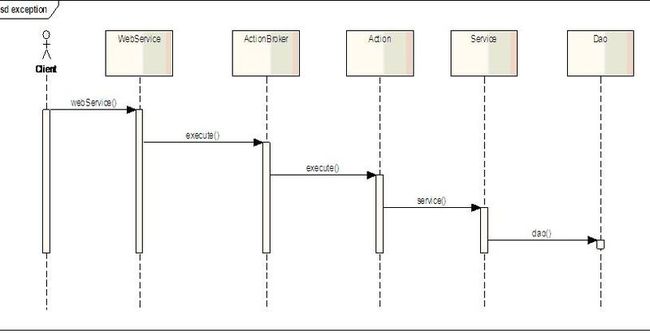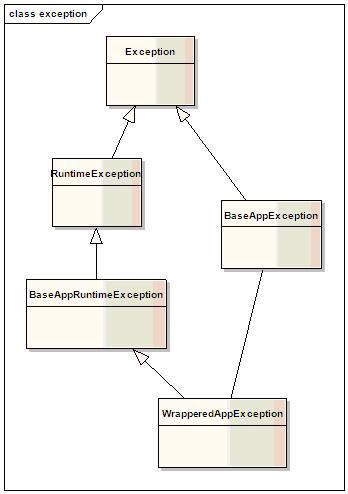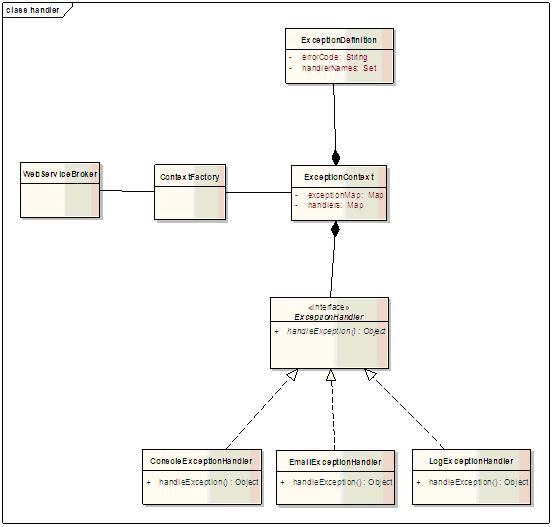原创整理不易,转载请注明出处:在java Spring基础上实现自定义异常处理框架教程
代码下载地址:http://www.zuidaima.com/share/1774096228535296.htm
应用项目大致的体系结构:
该异常处理框架满足的要求:
- 完整的异常组织结构
- 异常的统一处理
- 可配置,受管式,方便使用
完整的异常组织结构:
- 用户可以方便的定义自己的异常,但所有UncheckedException需要继承BaseAppRuntimeException,所有的checked Exception可以继承BaseAppException,或者需要抛出且不需要check时用WrapperredAppException封装后抛出
- 合理地使用checked异常
- Exception有唯一的error code,这样用户报告异常后,可以根据异常号找到相应Exception,把exception直接显示给用户也没有太大的意义,如何纪录exception那就是下文讲到的ExceptionHandler的职责了。
- 如果是第三方包括jdk中的异常,需要封装成BaseAppException或者BaseAppRuntimeException后抛出
统一的异常处理
异常统一在框架中进行处理,不需要在上层应用的代码中去处理抛出的异常。为了尽量捕捉到所有的异常,将异常处理放在了ActionBroker中,这样凡是action以后抛出的异常都可以捕捉到,因为webservice只是简单的调用action类的方法,一般不会出现异常。当我们捕捉到异常后,需要进行异常处理,定义了ExceptionHandler接口,用接口抽象出异常处理类的具体实现。
USFContextFactory: 创建ExceptionContext的工厂
package com.ldd0.exception.context;
public class CoreContextFactory {
private static CoreContextFactory instance;
private volatile ExceptionContext exceptionContext;
private Object exceptionContextLock = new Object();
private CoreContextFactory() {
}
public static synchronized CoreContextFactory getInstance() {
if (null == instance) {
instance = new CoreContextFactory();
}
return instance;
}
public ExceptionContext getExceptionContext() {
ExceptionContext tempExpContext = exceptionContext;
if (tempExpContext == null) {
synchronized (exceptionContextLock) {
tempExpContext = exceptionContext;
if (tempExpContext == null)
exceptionContext = tempExpContext = new ExceptionContext();
}
}
return tempExpContext;
}
}
ExceptionContext: 存放全局的exception信息
package com.ldd600.exception.context;
import java.util.ArrayList;
import java.util.Collection;
import java.util.Collections;
import java.util.HashMap;
import java.util.List;
import java.util.Map;
import java.util.Set;
import org.springframework.util.Assert;
import com.ldd600.exception.base.BaseAppRuntimeException;
import com.ldd600.exception.base.ConfigException;
import com.ldd600.exception.base.handler.ExceptionHandler;
import com.ldd600.exception.config.ExceptionDefinition;
public class ExceptionContext {
private Map<Class<?>, ExceptionDefinition> exceptionMap;
private Map<String, ExceptionHandler> handlers = new HashMap<String, ExceptionHandler>();
ExceptionContext() {
exceptionMap = new HashMap<Class<?>, ExceptionDefinition>();
}
public boolean containsException(Class<?> expClazz) {
return (exceptionMap.containsKey(expClazz));
}
public void addExceptionHander(Class<?> expClazz, Class<? extends ExceptionHandler> handlerClazz) {
try {
ExceptionDefinition definition = getRealExceptionDefinition(expClazz);
if (null == definition) {
throw new IllegalArgumentException(expClazz.getName() + "not in the context, please configure or add it to the context first!!");
}
ExceptionHandler handler = handlers.get(handlerClazz.getName());
if (null == handler) {
handler = handlerClazz.newInstance();
handlers.put(handlerClazz.getName(), handler);
}
definition.getHandlerNames().add(handlerClazz.getName());
} catch (Exception ex) {
throw new ConfigException("Add exception handler to context failure!", ex);
}
}
public void addExceptionHandler(Class<?> expClazz, String errorCode, Class<? extends ExceptionHandler> handlerClazz) {
Assert.hasLength(errorCode, expClazz + " errorCode must not be null or empty string!");
ExceptionDefinition definition = getRealExceptionDefinition(expClazz);
if(null == definition) {
definition = new ExceptionDefinition(errorCode);
exceptionMap.put(expClazz, definition);
}
addExceptionHander(expClazz, handlerClazz);
}
public void addExceptionHandlers(Class<?> expClazz, Class<? extends ExceptionHandler> handlerClazzes) {
for(Class<? extends ExceptionHandler> handlerClazz : handlerClazzes) {
addExceptionHander(expClazz, handlerClazz);
}
}
public void removeExceptionHandler(Class<?> expClazz, Class<? extends ExceptionHandler> handlerClazz) {
Assert.isTrue(containsException(expClazz));
String handlerName = handlerClazz.getName();
getExceptionDefinition(expClazz).getHandlerNames().remove(handlerName);
Collection<ExceptionDefinition> definitons = exceptionMap.values();
boolean isClearHandler = true;
for (ExceptionDefinition expDefinition : definitons) {
if (expDefinition.getHandlerNames().contains(handlerName)) {
isClearHandler = false;
break;
}
}
if (isClearHandler) {
handlers.remove(handlers.get(handlerName));
}
}
public void setExceptionDefinition(Class<?> expClazz, ExceptionDefinition definition) {
exceptionMap.put(expClazz, definition);
}
public ExceptionDefinition getExceptionDefinition(Class<?> expClazz) {
if (containsException(expClazz)) {
return exceptionMap.get(expClazz);
} else if (BaseAppRuntimeException.class.isAssignableFrom(expClazz.getSuperclass())) {
return getExceptionDefinition(expClazz.getSuperclass());
} else {
return null;
}
}
public ExceptionDefinition getRealExceptionDefinition(Class<?> expClazz) {
return exceptionMap.get(expClazz);
}
public List<ExceptionHandler> getExceptionHandlers(Class<?> expClazz){
ExceptionDefinition definition = getExceptionDefinition(expClazz);
if (null != definition) {
Set<String> handlerNames = definition.getHandlerNames();
List<ExceptionHandler> handlerList = new ArrayList<ExceptionHandler>(handlerNames.size());
for (String handlerName : handlerNames) {
ExceptionHandler handler = handlers.get(handlerName);
handlerList.add(handler);
}
List<ExceptionHandler> resultHandlerList = new ArrayList<ExceptionHandler>(handlerList);
return resultHandlerList;
} else {
return Collections.<ExceptionHandler> emptyList();
}
}
public String getErrorCode(Class<?> expClazz){
ExceptionDefinition definition = getExceptionDefinition(expClazz);
if (null != definition) {
return definition.getErrorCode();
} else {
return "";
}
}
}
ExceptionDefinition: Exception信息单元
package com.ldd0.exception.config;
import java.util.LinkedHashSet;
import java.util.Set;
public class ExceptionDefinition {
private String errorCode;
private Set<String> handlerNames = new LinkedHashSet<String> ();
ExceptionDefinition() {
}
public ExceptionDefinition(String errorCode) {
this.errorCode = errorCode;
}
public String getErrorCode() {
return errorCode;
}
public void setErrorCode(String errorCode) {
this.errorCode = errorCode;
}
public Set<String> getHandlerNames() {
return handlerNames;
}
}
ExceptionDefiniton定义了和某个exception相关的具体信息,根据exception的class name可以从exceptionContext中的exceptionMap得到指定的exception的相关信息,这些信息是在系统初始化时读取到exceptionContext中的。并且避免了exception handler的重复初始化。
可配置,受管式,方便使用
采取两种配置方式,exception的相关信息比如它的errorCode, exceptionHandlers可以配置在外部的xml文件中,也可以用annotation标注。对于exception的处理是有继承性质的,如果某个exception没有在exceptionContext中注册,就使用它的父类的配置信息。如果无任何父类在exceptionContext中注册,就使用默认机制进行处理。
XML 方案:
因为spring2.0支持自定义schema功能,我们可以方便地采用自己的schema只要实现NamespaceHandler和BeanDefinitionPaser,后面一个比较重要,可以将自定义xml文件中的相关类注册到spring的上下文中,成为spring bean。
Xml schema:
<xsd:complexType name="exceptionType">
<xsd:sequence>
<xsd:element name="level" default="error" minOccurs="0">
<xsd:simpleType>
<xsd:restriction base="xsd:string">
<xsd:enumeration value="error" />
<xsd:enumeration value="warning" />
<xsd:enumeration value="info" />
<xsd:enumeration value="confirmation" />
</xsd:restriction>
</xsd:simpleType>
</xsd:element>
<xsd:element name="handler" maxOccurs="unbounded">
<xsd:simpleType>
<xsd:restriction base="xsd:string" />
</xsd:simpleType>
</xsd:element>
</xsd:sequence>
<xsd:attribute name="errorCode">
<xsd:simpleType>
<xsd:restriction base="xsd:string">
<xsd:whiteSpace value="preserve" />
<xsd:pattern value="LDD600-+\d{1,5}.*" />
</xsd:restriction>
</xsd:simpleType>
</xsd:attribute>
<xsd:attribute name="class" type="xsd:string" use="required" />
</xsd:complexType>
Annotation方案:
JDK1.5以上就有了annotation,可以简化我们的配置,使得配置信息和代码联系在一起,增加了代码的可读性。如何在spring中注册自定义的annotation和用annotation标注的class,可以参考文章2和文章: 。对于每个注册了的class用ExceptionalAnnotationBeanPostProcessor来parse具体的annotation信息(对于annotation的parse方法还会在以后继续改进)。
package com.ldd600.exception.processor;
import org.springframework.beans.BeansException;
import org.springframework.beans.factory.config.BeanPostProcessor;
import com.ldd600.exception.annotation.Exceptional;
import com.ldd600.exception.base.BaseAppException;
import com.ldd600.exception.base.BaseAppRuntimeException;
import com.ldd600.exception.config.ExceptionDefinition;
import com.ldd600.exception.context.ExceptionContext;
import com.ldd600.exception.context.CoreContextFactory;
public class ExceptionalAnnotationBeanPostProcessor implements BeanPostProcessor {
public Object postProcessAfterInitialization(Object bean, String beanName) throws BeansException {
if(bean instanceof BaseAppRuntimeException || bean instanceof BaseAppException) {
Exceptional exceptional = bean.getClass().getAnnotation(Exceptional.class);
if(null != exceptional) {
ExceptionContext ctx = CoreContextFactory.getInstance().getExceptionContext();
if(!ctx.containsException(bean.getClass())) {
ExceptionDefinition expDefinition = new ExceptionDefinition(exceptional.errorCode());
ctx.setExceptionDefinition(bean.getClass(), expDefinition);
}
ctx.addExceptionHandlers(bean.getClass(), exceptional.handlers());
return null;
}
}
return bean;
}
public Object postProcessBeforeInitialization(Object bean, String beanName) throws BeansException {
return bean;
}
}
结果测试:
package com.ldd600.exception.test;
import org.jmock.Expectations;
import org.jmock.Mockery;
import org.springframework.beans.factory.BeanFactory;
import com.ldd600.exception.action.BusinessAction;
import com.ldd600.exception.base.BaseAppException;
import com.ldd600.exception.base.BaseAppRuntimeException;
import com.ldd600.exception.base.ConfigException;
import com.ldd600.exception.base.handler.ConsoleHandler;
import com.ldd600.exception.context.CoreContextFactory;
import com.ldd600.exception.dto.DefaultRequest;
import com.ldd600.exception.dto.DefaultResponse;
import com.ldd600.exception.dto.Request;
import com.ldd600.exception.dto.Response;
import com.ldd600.exception.webservice.ActionBrokerImpl;
public class ExceptionTest extends DependencyInjectionExceptionTestCase {
Mockery context = new Mockery();
ActionBrokerImpl broker = new ActionBrokerImpl();
final Request request = new DefaultRequest();
final Response response = new DefaultResponse();
@Override
protected String[] getConfigLocations() {
return new String[] { "applicationContext.xml" };
}
public void testExceptionThrow() {
final BusinessAction<Response, Request> action = context
.mock(BusinessAction.class);
final BeanFactory beanFactory = context.mock(BeanFactory.class);
assertThrowing(new Closure() {
public void run() throws Throwable {
context.checking(new Expectations() {
{
allowing(beanFactory).getBean("action");
will(returnValue(action));
one(action).execute(request, response);
will(throwException(new BaseAppException()));
}
});
broker.setExceptionHandler(new ConsoleHandler());
broker.setBeanFactory(beanFactory);
broker.execute("action", request, response);
}
}, BaseAppException.class);
}
public void testExceptionalAutoLoad() throws BaseAppException {
final BeanFactory beanFactory = context.mock(BeanFactory.class);
final BusinessAction<Response, Request> action = context
.mock(BusinessAction.class);
context.checking(new Expectations() {
{
allowing(beanFactory).getBean("action");
will(returnValue(action));
one(action).execute(request, response);
will(throwException(new ConfigException()));
}
});
broker.setBeanFactory(beanFactory);
broker.execute("action", request, response);
assertEquals(CoreContextFactory.getInstance().getExceptionContext()
.getErrorCode(ConfigException.class), "LDD600-00002");
context.assertIsSatisfied();
}
public void testRuntimeException() {
final BusinessAction<Response, Request> action = context
.mock(BusinessAction.class);
final BeanFactory beanFactory = context.mock(BeanFactory.class);
assertThrowing(new Closure() {
public void run() throws Throwable {
context.checking(new Expectations() {
{
allowing(beanFactory).getBean("action");
will(returnValue(action));
one(action).execute(request, response);
will(throwException(new BaseAppRuntimeException()));
}
});
broker.setExceptionHandler(new ConsoleHandler());
broker.setBeanFactory(beanFactory);
broker.execute("action", request, response);
}
}, BaseAppRuntimeException.class);
// test config
assertEquals(CoreContextFactory.getInstance().getExceptionContext()
.getErrorCode(BaseAppRuntimeException.class), "LDD600-00001");
// test handler
assertFalse(response.isSuccess());
assertEquals(response.getErrorCode(), CoreContextFactory.getInstance()
.getExceptionContext().getErrorCode(
BaseAppRuntimeException.class));
context.assertIsSatisfied();
}
public void testCheckedException() {
final BusinessAction<Response, Request> action = context
.mock(BusinessAction.class);
final BeanFactory beanFactory = context.mock(BeanFactory.class);
assertThrowing(new Closure() {
public void run() throws Throwable {
context.checking(new Expectations() {
{
allowing(beanFactory).getBean("action");
will(returnValue(action));
one(action).execute(request, response);
will(throwException(new ExceptionFaker()));
}
});
broker.setBeanFactory(beanFactory);
broker.execute("action", request, response);
}
}, ExceptionFaker.class);
// test config
assertEquals(CoreContextFactory.getInstance().getExceptionContext()
.getErrorCode(ExceptionFaker.class), "LDD600-00003");
// test handler
assertFalse(response.isSuccess());
assertEquals(response.getErrorCode(), CoreContextFactory.getInstance()
.getExceptionContext().getErrorCode(
ExceptionFaker.class));
context.assertIsSatisfied();
}
}
参考资料:
文章1:http://www.onjava.com/pub/a/onjava/2006/01/11/exception-handling-framework-for-j2ee.html
文章2:http://sannotations.sourceforge.net/
本文源代码:源代码下载


